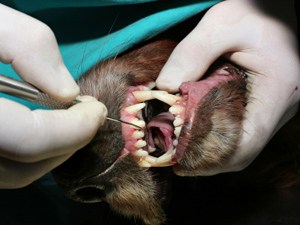Pet Dental Care for Health & Long Life

Dental care is one of the most effective ways to prolong your pet’s life and prevent the chronic discomfort that accompanies dental disease. For us, caring for our teeth and gums is part of our daily routine. We understand that without this daily attention and without regular visits to the dentist, serious problems with our teeth and gums would develop. Your pet needs dental care to prevent problems, too. Pets do not complain much, but those with significant periodontal disease routinely start acting happier and livelier once their dental problems are addressed. Those pets that receive routine dental care have fewer heart, lung, kidney, and liver problems as they mature, as well as nicer breath!
View the AAHA Dental Care Guidelines.
Signs of Dental Disease
Dental disease starts when soft plaque (the thin, sticky film that builds up on the teeth) inflames the gums, a condition called "gingivitis." If your pet has bad breath and reddened gums, it could be from gingivitis.
Gingivitis can lead to "periodontitis," or inflammation of the tissues around the teeth. If left untreated, periodontitis can cause loss of teeth and infections in the heart or kidneys. Periodontitis also makes it painful to eat; therefore, your pet could lose his or her appetite and even lose weight.
Commonly, though, physical signs of dental disease are not obvious, even when advanced. That is why it’s so important to have your pet’s teeth checked regularly by a veterinarian.
Pet Dental Exam and Cleaning
First, your veterinarian will examine your pet to evaluate his or her health status. The veterinarian will recommend pre-anesthetic blood work and other testing to confirm that your pet is at low risk for complications from anesthesia. Anesthesia is absolutely necessary for a thorough cleaning and dental treatment. Recent guidelines from the AAHA require accredited practices to anesthetize and intubate patients for all dental prophylaxis in order to pass the AAHA Accreditation Evaluation.
During the dental cleaning, the veterinarian examines your pet’s mouth and looks for abnormalities such as broken teeth, missing teeth, ulcers, or tumors. He or she uses a periodontal probe to check for pockets underneath the gum line, where periodontal disease starts. The doctor removes plaque and tartar (calcified plaque) with an ultrasonic scaler and uses a hand scaler to remove plaque and tartar from crevices and underneath the gum line. After cleaning below the gum line, the doctor will polish your pet’s teeth, which smoothes out any scratches in the enamel. Some teeth may require extraction if they are loose or badly infected. In some cases, our veterinarian may refer you to a board-certified veterinary dentist for services such as root canals and crowns.
Home Dental Care for Your Pet
Dental care does not end with a visit to your veterinarian. Brushing your pet’s teeth is an important part of home dental care. Just think how your teeth would look and how your breath would smell if you brushed your teeth once a week or less!

